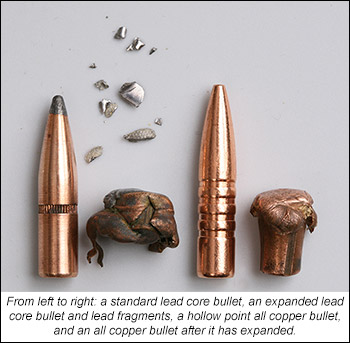Lead Exposure of Tribal Members
BY
Steve Mortensen, DRM Fish and Wildlife Biologist
Jason Helgeson, DRM Environmental Contaminants Specialist
Dr. Paul Kapfer, DRM Wildlife Biologist
In recent years there has been increasing concerns about lead contamination in game harvested by hunters and how this lead may be detrimental to the health of humans as well as non-target wildlife. The source of lead is primarily from lead-cored rifle bullets used for deer hunting and lead shot used for bird hunting.
 Lead is a soft metal that is rarely found in its elemental form in nature. Due to its soft nature and multitude of uses in construction and manufacturing, lead is widely used around the world. Lead is of most concern to children and woman who plan to have children. Lead poisoning causes neurological, blood, and brain disorders that can be quite serious. In children, this can lead to learning disabilities and other chronic problems. Prior to 1978, lead was widely used in house paint. When paint flakes off and is consumed by children, lead poisoning will occur. It has since been banned from this use.
Lead is a soft metal that is rarely found in its elemental form in nature. Due to its soft nature and multitude of uses in construction and manufacturing, lead is widely used around the world. Lead is of most concern to children and woman who plan to have children. Lead poisoning causes neurological, blood, and brain disorders that can be quite serious. In children, this can lead to learning disabilities and other chronic problems. Prior to 1978, lead was widely used in house paint. When paint flakes off and is consumed by children, lead poisoning will occur. It has since been banned from this use.
Major efforts are underway to remove lead from consumer products. Lead was used as an additive in gas for many years, but it was removed from gasoline due to environmental concerns. Plumbing pipes also used to be made of lead or used lead to connect pipe joints, but this use has also been banned. Almost all electronics equipment uses lead solder to connect components, but we are seeing it phased out from this use to protect employees and reduce disposal costs.
Lead has also been banned from use in waterfowl hunting due to the huge number of duck that died annually from lead poisoning due to ingesting lead pellets from the lake bottom. Despite these efforts tribal members experience increased exposure rates due to high subsistence gathering rates and continued use of lead shot for upland game hunting and lead-cored rifle bullets used in big game hunting.
Lead is not only a concern for humans, but also animals that consume carcasses or gut piles that contain lead fragments. Currently about 80 %of eagles sampled in this region have elevated lead levels and 30% of the injured eagles the Division of Resources Management handles are suffering from acute lead poisoning. This is higher than the state-wide average, partially because tribal hunting season starts earlier and runs 16 weeks as opposed to the two to three weeks season over much of the rest of the state. Eagles frequently scavenge, and gut piles are a prized food source for them before many of them head south for the winter. Due to the nature of a bird’s digestive system they are lethally poisoned by even a few small fragments of lead.
You can reduce the risk of lead poisoning for you and your family, as well as wildlife, by following a few simple guidelines. The first is to stop using lead-cored bullets and shot. Copper and other alloys bullets are available for many calibers of rifles and shot shell alternatives have been around for decades. Although this ammunition tends to be a little more expensive, it has the potential to reduce human exposure to lead to zero. It is not available in all calibers, but is becoming more widely available every year.
The other alternative is to widely cut and remove all tissue that is damaged or bloodshot around the bullet wound. However, this will only lesson exposure, but will not eliminate it entirely. Studies have found that small bullet fragments, too small to see or feel, can travel as far as 18 inches from the bullet wound channel. Some guidelines even recommend that children and women of child bearing years do not consume venison harvested with bullets containing lead. You can also reduce your exposure to lead by shooting animals high in the neck and not using this portion of the animal. In order to lessen the exposure of lead to wildlife, like eagles that consume gut piles, it will be necessary to remove these materials from the field or otherwise dispose of them so wild animals cannot come in contact with them.
Links for more lead information
http://www.health.state.mn.us/divs/eh/lead/index.html
http://www.dnr.state.mn.us/hunting/lead/index.html
Contact Us
DRM (218) 335-7400
| Name | Title | Phone |
| Mortensen, Steve | Fish, Wildlife & Plant Resources Program Director | 335-7421 |
| Finn, Jon | Fish & Wildlife Field Specialist | 335-7424 |
| White, Gary | Assistant Hatchery Manager | 335-7424 |
| Robinson, Martin | Fish and Wildlife Technician | 335-7424 |















 Division of Resource Management
Division of Resource Management